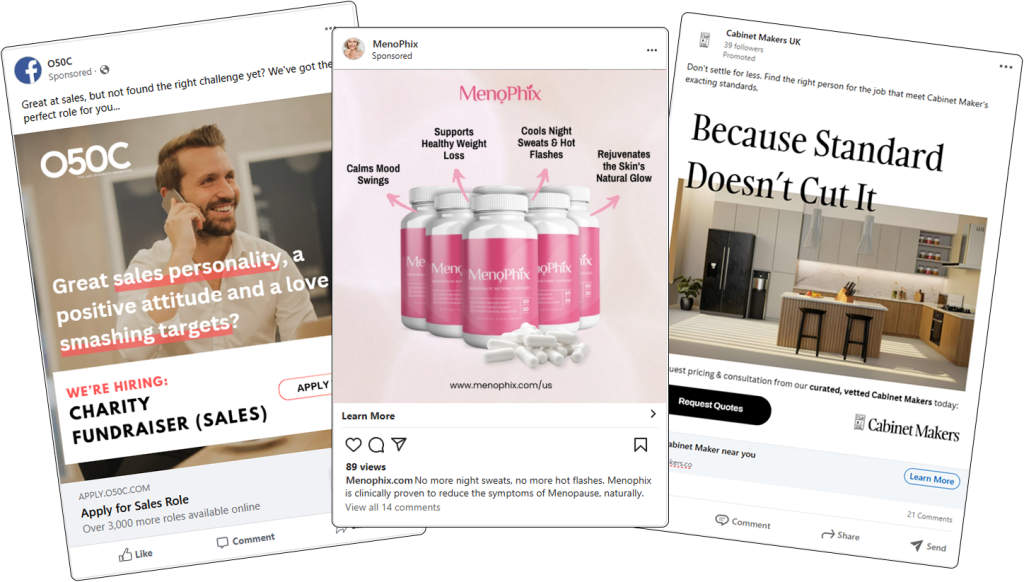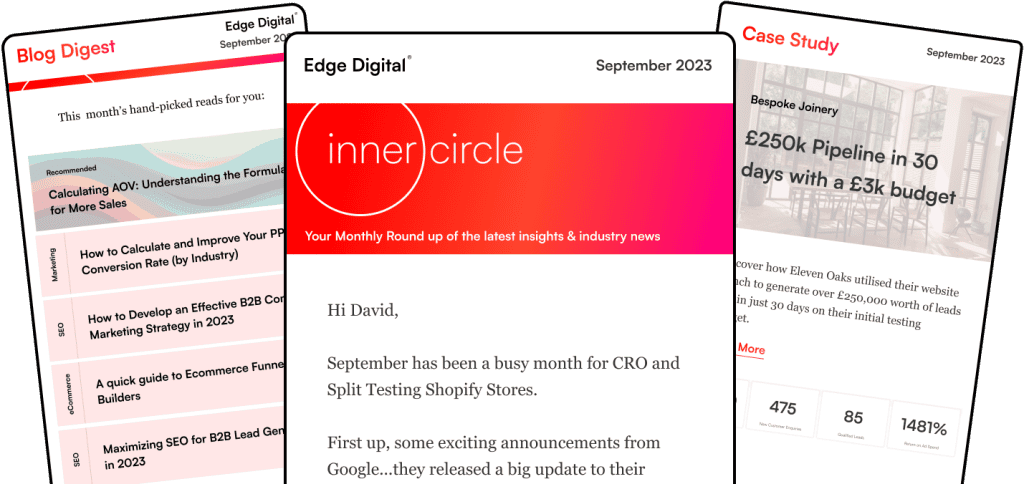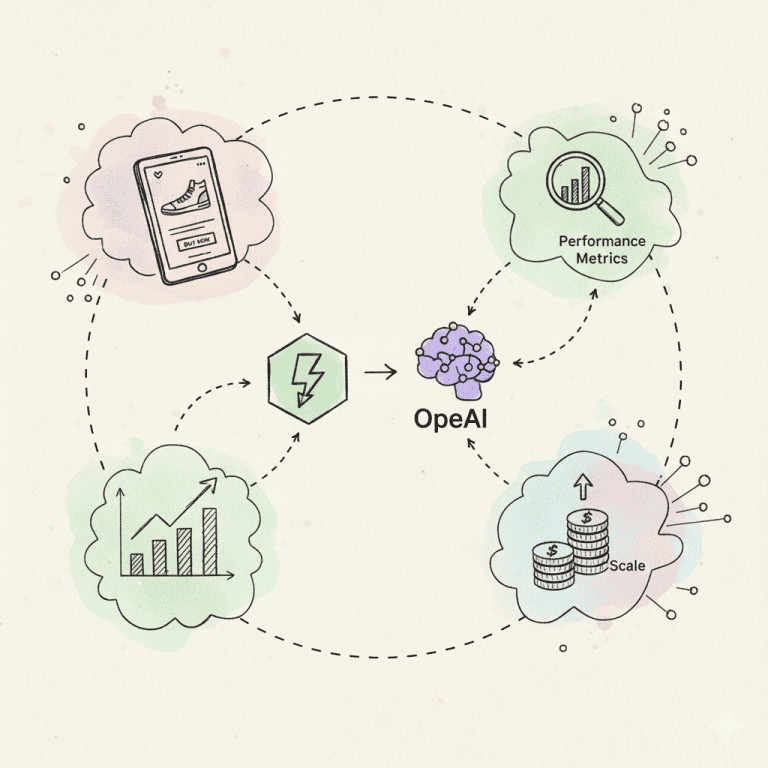Google’s advertising options can be confusing with so many campaign types available. If you’re trying to decide between Performance Max, Standard Shopping, and Search campaigns, you’re not alone.
The main difference is that PMax campaigns run across all Google placements and use automation, while Standard Shopping focuses on product listings in search results, and Search campaigns target specific keywords with more manual control.
We’ve seen many advertisers struggle with choosing the right campaign type. Standard Shopping campaigns provide precision and transparency, giving you direct control over which products appear for specific searches.

On the other hand, Performance Max offers cross-channel reach and leverages Google’s machine learning to optimise your ads across YouTube, Display, Search, Discover, Gmail, and Maps.
It’s worth noting that Google has recently deprioritised Performance Max versus Standard Shopping campaigns, which might influence your strategy going forward. The key is understanding when each campaign type shines and how they might work together in your advertising mix.
Key Takeaways
- Performance Max offers broader reach across all Google platforms with automated optimisation, whilst Standard Shopping provides more transparency and control for product listings.
- Search campaigns excel with specific keyword targeting and typically have higher click-through rates for precise search terms compared to the broader approach of PMax.
- The ideal strategy often involves using multiple campaign types together, with different campaign structures based on your specific business goals and measurement capabilities.
Understanding Performance Max, Shopping, and Search Max Campaigns
Google Ads offers several campaign types for advertisers looking to maximise their online visibility. Each campaign type has unique features, targeting options and benefits for different marketing goals and business needs.
What Is Performance Max?
Performance Max is Google’s AI-powered campaign type that runs ads across Google’s entire advertising network. It leverages machine learning to optimise ad placements and bidding automatically.
Performance Max campaigns require asset groups with various creative elements including:
- Images and videos
- Headlines and descriptions
They also require your business name and logo, as well as audience signals. The main advantages include:
- Broader reach across YouTube, Display, Search, Discover, Gmail and Maps
- Simplified management through automation
Performance Max campaigns are particularly useful for e-commerce businesses. They analyse your website content, ads, and product feed to determine which keywords trigger your ads on both search and shopping networks.
What Are Shopping Campaigns?
Standard Shopping campaigns display product listings on Google Search and the Shopping tab. They’re specifically designed for e-commerce businesses selling physical products.
Shopping campaigns require:
- An active Google Merchant Center account
- A well-structured product feed
These campaigns offer more granular control over individual product bidding, budget allocation by product groups, and campaign structure. Standard Shopping allows retailers to showcase product images, prices, and shop names directly in search results.
This format typically drives higher click-through rates than text ads for product searches. Until recently, Performance Max would automatically take precedence, but now Ad Rank determines which ad serves for each auction.
What Is Search Max?
Search Max is a newer campaign type that combines elements of traditional search campaigns with Performance Max automation. It focuses exclusively on the search network while using AI for optimisation.
Key features include:
- Keyword targeting with automated expansion
- Smart bidding for conversion optimisation
It also offers dynamic ad creation based on landing pages and integration with Dynamic Search Ads (DSA) technology. Search Max helps advertisers who want the AI benefits of Performance Max but prefer to stay within the search network.
With Search Max, we still maintain more control over where our ads appear compared to Performance Max, while benefiting from Google’s machine learning to identify valuable search queries we might have missed.
Key Differences Between PMax, Shopping, and Search Max
Understanding the distinctions between these campaign types helps advertisers choose the right approach for their specific goals. Each campaign type offers unique advantages in terms of control, reach, and targeting capabilities.
Campaign Objectives and Use Cases
PMax (Performance Max) campaigns work best for advertisers seeking to maximise conversions across multiple Google platforms simultaneously. We’ve found that PMax is particularly effective for ecommerce businesses targeting warm audiences who have previously engaged with your brand.
Standard Shopping campaigns are ideal when you need more granular control over product promotion. They excel in situations where you want to optimise bids at the product level, target specific product categories, test different bidding strategies, or maintain tighter budget control.
Search campaigns shine when you need to capture high-intent traffic based on specific keywords. They’re particularly valuable when targeting users actively searching for your products, matching exact search queries with tailored messaging, or focusing exclusively on search-based traffic.
Advertising Channels and Ad Formats
PMax offers the broadest reach, spanning multiple Google properties simultaneously. Your ads can appear across:
- Google Search Network
- Shopping results
They can also show on YouTube, Gmail, Discovery feeds, and the Display Network. This multi-channel approach enables diverse ad formats including text, responsive display, video, and image ads.
Standard Shopping campaigns are more limited, appearing primarily in Shopping tabs and Google Search results (product listings). They exclusively use product feed information to create visual shopping ads.
Search campaigns operate solely within the Google Search Network, utilising text-based ads. While the reach is narrower, the focused approach often delivers highly qualified traffic.
Targeting Capabilities
PMax relies heavily on Google’s AI to identify potential customers. We provide assets and audiences, but Google’s algorithms determine the targeting specifics.
Key targeting elements include:
- Audience signals: Suggest audiences but can’t restrict to them
- Creatives: Provide multiple formats for algorithm testing
Standard Shopping offers moderate targeting control. We can set product group priorities, implement negative keywords, adjust bids based on product attributes, and target specific locations and devices.
Search campaigns provide the most precise targeting capabilities. We maintain control over exact keyword targeting (broad, phrase, exact match), audience layering, ad scheduling, geographic targeting, and device targeting.
This specificity makes search campaigns excellent for targeted messaging to high-intent audiences.
Budgeting and Bidding Strategies
When managing multiple Google ad campaigns, understanding how to allocate budget and select appropriate bidding strategies is crucial for maximising returns. The right approach varies significantly between Performance Max, Shopping and Search campaigns.
Budget Allocation Across Campaign Types
Performance Max campaigns typically require larger budgets than standard Shopping campaigns due to their broad reach across Google’s entire inventory. We recommend starting with 15-20% of your total ad spend on PMax and adjusting based on performance.
Standard Shopping campaigns work well with tighter budgets as you can control exactly where your money goes. When budget is particularly tight, Standard Shopping often delivers more predictable results since you can manually adjust spending on specific products.
For multi-campaign strategies, consider this allocation approach:
- 50% to your best-performing campaign type
- 30% to secondary campaigns
Reserve 20% for testing new approaches. This balanced distribution prevents any single campaign from consuming your entire budget while still allowing for optimisation.

Bidding Models and Strategies
Standard Shopping campaigns offer greater control over bidding, allowing both manual and automated bidding options. Manual bidding works well for newer accounts with limited conversion data.
For Performance Max, automated bidding is mandatory, with options including:
- Target ROAS: Best for established accounts with consistent conversion history
- Maximise Conversions: Ideal for new campaigns focused on volume
Target CPA is suitable when you have a fixed cost-per-acquisition target. When combining multiple campaign types, we recommend using different bidding strategies for each to diversify your approach.
Budget pacing is equally important. We suggest daily budgets for testing periods and shared budgets when running similar campaign types to prevent underspending in high-performing areas.
Conversion Tracking and Measurement
Effective tracking and measurement form the backbone of successful Google Ads campaigns. The way conversion data is captured and utilised varies significantly between Performance Max, Shopping and Search campaigns.
Measuring Conversions and Revenue
Performance Max campaigns rely heavily on Google’s automated systems to track and optimise for conversions. These campaigns use machine learning to find potential customers across Google’s entire network.

With PMax, we get aggregated conversion data rather than the granular insights available in other campaign types. Standard Shopping campaigns offer more transparent conversion tracking.
We can see exactly which products drive conversions and revenue, allowing for more precise optimisation at the product level. Search campaigns provide the most detailed conversion attribution, showing which keywords and search terms lead to sales.
This clarity enables us to identify high-converting search terms, adjust bids on specific keywords, and understand the customer journey more comprehensively.
Optimising for CPA and ROAS
When optimising for Cost Per Acquisition (CPA) or Return On Ad Spend (ROAS), each campaign type offers different approaches. Performance Max prioritises automation and lets Google’s algorithms handle the heavy lifting.
We simply set our target CPA or ROAS, and the system works to achieve these goals across multiple channels. Shopping campaigns provide more control over optimisation.
We can manually adjust bids for specific product groups based on performance data and make strategic decisions about which products deserve more budget.
Granularity, Control, and Automation
When comparing PMax, Shopping and Search campaigns, understanding the balance between manual control and automation is crucial for making strategic decisions. The differences in how these campaign types handle granularity directly impacts your ability to optimise performance.
Level of Granular Control
Standard Shopping campaigns offer the highest level of granular control among these options. With these campaigns, we can manually adjust bids at the product group level and actively manage search terms that trigger our ads.
This granularity allows for precise optimisation of specific products based on performance data. In contrast, Performance Max campaigns provide less granular control due to their automated nature.
PMax limits our ability to exclude specific search terms, adjust bids at the product level, and control which products show for specific queries. The trade-off is that PMax campaigns handle the complex work of distributing budgets and targeting across Google’s entire network automatically.
Role of Automation and Machine Learning
Performance Max represents Google’s most advanced use of automation and machine learning. These campaigns automatically distribute budget across channels, test different creative combinations, and optimise for conversion goals across platforms.
PMax uses machine learning to identify the best-performing placements and audiences, requiring less manual intervention than Standard Shopping campaigns. This automation can save significant time for advertisers but requires surrendering some control.
Standard Shopping requires more manual work but allows for precise targeting through negative keywords and specific product group optimisations. The effectiveness ultimately depends on your team’s expertise and available resources.
Creative Assets and Ad Creation Process
The creative assets you use and how you build your ads significantly impact campaign performance across Google’s advertising platform. Different campaign types require unique approaches to ad creation and asset optimisation for maximum effectiveness.

Ad Creation Across Campaign Types
When creating ads for Performance Max campaigns, you’ll need to provide multiple asset types as it runs across all of Google’s networks. You must upload various creative elements including headlines, descriptions, images, videos, and logos.
For Standard Shopping campaigns, the ad creation process is simpler. You primarily need product data from your feed with limited customisation options.
Search campaigns require text-based assets focused on keywords, with headlines and descriptions being the primary creative elements. This offers more direct control over messaging but fewer visual options.
Optimising Assets for Best Performance
To maximise campaign results, we recommend conducting regular asset reviews. Performance Max campaigns rely heavily on machine learning to test combinations of your assets across different placements like YouTube, Gmail, and Discovery feeds.
For PMax assets, focus on creating high-quality, diverse images that work in different aspect ratios. Develop clear, benefit-focused headlines with strong calls-to-action and produce short, engaging videos (or allow Google to create them).
With Standard Shopping, optimise your product feed with accurate titles, descriptions, and high-quality images. Product data quality directly impacts performance.
For Search campaigns, test multiple headline variations and monitor which perform best. Unlike PMax, you’ll have more granular control over which assets appear where.
Audience and Targeting Expansion
The different Google ad campaign types offer varying capabilities for reaching potential customers and refining your targeting approach. Performance Max provides the broadest reach, while Shopping and Search campaigns offer more specific targeting controls.
Reaching New Audiences
Performance Max campaigns excel at audience reach, extending your ads across Google’s entire ecosystem including YouTube, Gmail, and Discover. This expansive visibility helps brands connect with prospects who might never have encountered their products otherwise.
In contrast, Shopping campaigns target users actively searching for products like yours, focusing on high-intent traffic. They’re brilliant for capturing consumers already in the buying journey, but they won’t help much with brand awareness.
Search campaigns excel at targeting specific audience segments based on search behaviour. We can tailor these campaigns to reach users at precise moments in their decision-making process.
User behaviour signals vary significantly between these campaign types. PMax leverages Google’s AI to identify patterns in consumer behaviour across multiple touchpoints, whilst Shopping campaigns focus primarily on product-seeking behaviours.
Advanced Targeting Techniques
PMax campaigns offer sophisticated audience targeting through automated signals, but provide less direct control. Google’s AI handles optimisation, which can be both a strength and limitation.
With Shopping campaigns, we maintain greater control over targeting options. We can set product group priorities, implement negative keywords, adjust bids at a granular level, and optimise for specific product categories.
Search campaigns provide the most refined keyword targeting capabilities. We can target exact match keywords, implement broad match modifiers, use negative keywords extensively, and create audience segments based on previous site interactions.
The multi-channel reach of PMax makes it exceptionally powerful for expanding your audience. However, Search campaigns still offer unparalleled precision when targeting specific search intent, making them invaluable for bottom-funnel conversions.
Best Practices for Campaign Optimisation
Maximising the performance of your Google Ads requires strategic implementation of campaign types and consistent refinement based on real-world results. We’ve identified key approaches that can significantly boost your return on ad spend.
Combining and Testing Campaign Types
When optimising your ad strategy, running multiple Performance Max campaigns alongside other campaign types often yields the best results. We recommend creating separate PMax campaigns for different product categories or business goals to maintain focus and clarity.
For branded searches, consider implementing a standard Shopping or Search campaign with high priority settings. This approach prevents your PMax campaigns from capturing this traffic and potentially skewing your performance data.
To compare effectiveness, you can use Google’s built-in experimentation tools. The Performance Max experiments feature allows direct comparison with Standard Shopping campaigns, giving you clear insights about which performs better for your specific products.
Continuous Improvement and A/B Testing
A/B testing remains crucial for campaign optimisation, especially as Google continues to develop new features. Regular testing of different asset combinations in PMax campaigns can significantly improve conversion rates.
Start by establishing clear performance benchmarks before making changes. Test one variable at a time—whether it’s adjusting bidding strategies, refining audience signals, or updating creative assets.
For optimal results, allow campaigns sufficient learning time (typically 2-4 weeks) before making major adjustments. Performance Max relies heavily on machine learning, so providing high-quality conversion data is essential for the algorithm to optimise effectively.
Monitor your campaigns weekly, but resist making frequent changes that might disrupt the learning process. The most successful advertisers balance patience with proactive optimisation based on meaningful performance indicators rather than short-term fluctuations.

Choosing the Right Campaign Type for Your Goals
Selecting between Performance Max, Shopping, and Search Max campaigns requires matching each platform’s strengths with your specific business objectives and capabilities. The right choice can significantly impact your ROAS and overall campaign success.
Evaluating Business Needs and Resources
Before launching any campaign, assess your business goals carefully. Are you focused on maximising sales, generating leads, or increasing shop visits?
Budget considerations:
- Small budgets (under £500/month): Consider standard Shopping campaigns for precise control.
- Medium budgets: Test Performance Max in limited scope alongside existing campaigns.
- Large budgets: Implement a mix of campaign types for comprehensive coverage.
For e-commerce businesses with extensive product catalogues, Shopping campaigns offer granular product-level bidding. If you’re struggling with limited control and data visibility, Performance Max provides AI-driven optimisation across Google’s entire network.
We recommend evaluating your team’s capacity for campaign management. Shopping campaigns require more hands-on optimisation, while PMax needs less day-to-day management but more strategic oversight.
Scenario-Based Recommendations
For pure e-commerce:\
If you’re exclusively selling products online with clear conversion goals, standard Shopping campaigns offer better transparency. You’ll see exactly which products generate sales and can adjust accordingly.
When targeting specific CPA goals across multiple channels, Performance Max excels by automatically finding the best placements across Google’s network.
Mixed objective campaigns:
- Brand awareness + sales: Combine Search campaigns with PMax.
- Local shop visits + online sales: Use PMax with location extensions.
- New product launches: Start with Shopping for data collection, then expand to PMax.
For businesses seeking expansion, combining Performance Max with other Google Ads types often yields the best ROAS. Starting with Search Max or Shopping to gather baseline data, then gradually introducing PMax campaigns can prevent cannibalisation while maximising reach.
Frequently Asked Questions
Google Ads offers different campaign types with unique strengths and limitations. These FAQs address the key differences between Performance Max, Shopping and Search campaigns to help you choose the right approach for your business goals.
What distinguishes Performance Max campaigns from Standard Shopping campaigns?
Performance Max (PMax) campaigns use AI to automatically show your ads across all Google networks, including Search, Display, YouTube, Gmail and Discover. This automation gives PMax a wider reach than Standard Shopping campaigns.
Standard Shopping campaigns, in contrast, provide complete control over bid strategies and allow you to manage exactly where your ads appear. You can set specific bids for individual products or product groups.
PMax requires less manual management but offers fewer customisation options than Standard Shopping campaigns.
In what ways do Performance Max campaigns outperform traditional Smart Shopping campaigns?
Performance Max campaigns expand upon Smart Shopping’s automation while providing access to more networks. They incorporate additional assets like images, videos and text that can appear across various Google platforms.
PMax campaigns typically reach a larger audience than Smart Shopping, potentially generating more impressions and discovery opportunities. They also offer more detailed reporting capabilities and audience insights.
We’ve observed that PMax often generates a broader top-of-funnel presence, which can be valuable for new customer acquisition.
Can you elaborate on the specific advantages and disadvantages of using Performance Max versus Standard Shopping campaigns?
The main advantage of PMax is its comprehensive automation and wide reach across Google’s advertising networks. It’s particularly effective for advertisers with limited time for campaign management or those seeking new audience segments.
However, PMax’s automation means sacrificing granular control over where your budget gets spent. This can be frustrating if you want to prioritise specific networks or products.
Standard Shopping provides detailed control over bids and targeting, allowing for more precise optimisation. However, it requires more hands-on management and may not access all the placements that PMax can.
How do Shopping ads differ when created through Performance Max instead of regular Shopping campaigns?
Shopping ads created through PMax benefit from automatic placement across all of Google’s networks, not just the shopping tab and search results as with regular Shopping campaigns.
PMax shopping ads use your product feed combined with additional assets (images, videos, text) to create a variety of ad formats. This contrasts with regular Shopping campaigns that primarily use product feed data.
The visual presentation of the actual shopping listing may appear similar in both campaign types, but PMax can display your products in more varied contexts and formats.
What notable changes should advertisers expect when transitioning from Smart Shopping to Performance Max campaigns?
When transitioning to PMax, advertisers should prepare to provide additional creative assets like videos, images and headlines. These assets help PMax create ads for platforms beyond Shopping results.
The performance data structure differs in PMax, with reporting focused on the campaign as a whole rather than individual product groups. This can initially make performance analysis seem less transparent.
We’ve found that conversion tracking typically maintains continuity, though there may be a brief adjustment period as Google’s AI learns how to optimise the new campaign format.
In terms of campaign management and performance metrics, how do Performance Max campaigns compare with Search campaigns?
Search campaigns target specific keywords that signal user intent. PMax targets users across different networks based on their overall behaviour and interests.
This leads to different targeting approaches. Search campaigns often have higher conversion rates than PMax campaigns due to their intent-driven targeting.
PMax typically reaches a much wider audience. The management approach differs significantly.
Search campaigns require keyword research, match type selection and negative keyword management. PMax needs quality assets and audience signals but handles the targeting automatically.



